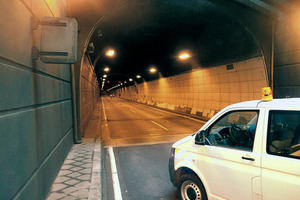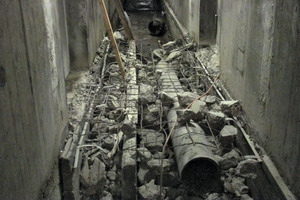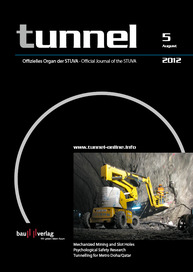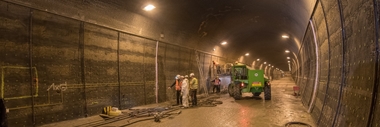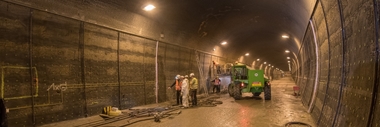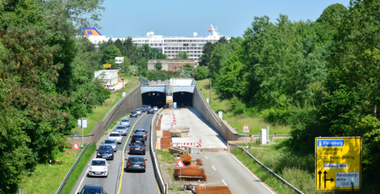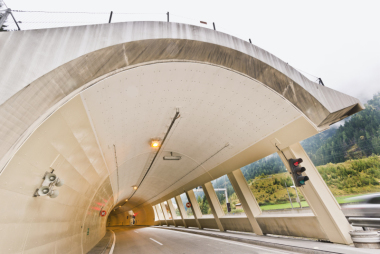General Renovation of the Rendsburg Canal Tunnel
The Rendsburg Canal Tunnel under the North-Baltic Sea Canal was opened for traffic in 1961. Since then the canal tunnel has been an important, practically indispensable part-section of the north-south axis along the B77 through Schleswig-Holstein – used by around 50,000 vehicles per day. After 50 years it is now time to thoroughly renovate the structure in spite of continuous maintenance measures over this period. In the process signs of wear will be removed, which could not be remedied through regular operations while traffic is still running. Redevelopment is scheduled to last 3 years. It is to be tackled in 3 phases. The conception for repairing the concrete was devised by the Federal Waterway Engineering and Research Institute (Bundesanstalt für Wasserbau) in Karlsruhe in conjunction with the Institute for Construction Research at the RWTH – Aachen University. The execution of planning for engineering and road construction as well as the production and plant engineering was provided by the Ingenieurbüro Pöyry Infra, Hamburg; the planning for restoring the concrete by the Ingenieurbüro Oemig und Partner from Kiel. Construction is being carried out by the Hamburg branch of the JV Züblin-Wisag.
The Rendsburg Tunnel is no sole instance: an increasing number of tunnels and bridges are reaching an age signifying that general redevelopment is essential. Hernani Esteves, the Group Manager for Cathodic Corrosion Protection at the Ed. Züblin AG has a key role to play in redeveloping the Rendsburg Canal Tunnel. He now explains the tasks, challenges and recognitions, which resulted for all those involved in restoring the structure.
Redeveloping a tunnel with traffic still running is in itself a challenge. Furthermore various activities have to be coordinated. Apart from restoring the reinforcement in the concrete and the application of cathodic corrosion protection, signal technology, drainage, ventilation and lighting have to be dealt with. Furthermore very constricted space conditions prevail in a service passage, which is only some 1.20 m wide – something which makes work a real challenge.
The tunnel redevelopment conception was worked out by Pöyry Infra GmbH as general planner and then appropriate tenders were invited by the client. Züblin was commissioned to fulfil a part of the contract and as responsible contractor is not involved in the conception.
It is customary to apply fire protection mortar in tunnels to safeguard fire protection. This is already known from past projects. The main task of a fire protection mortar is to secure a concrete covering on top of the steel reinforcement in the tunnel walls as the outermost layer. In this way the tunnel is able to withstand a fire structurally over a given period, so that those affected are given the time to escape. Special mortars of this kind have to be tested according to DIN 4102, Part 4. Towards this end the mortar is tried out in a fire test – with the duration and temperature geared to a special fire curve.
Cathodic corrosion protection is an electro-chemical method, a protective current is fed into the concrete by means of an electric current anode, which protects the steel reinforcement integrated in the concrete permanently from corrosion. Towards this end the anode is connected to the positive pole of a rectifier unit and the reinforcement to the negative one. The protective current is fed in by the surrounding tension; corrosion is either reduced to a negligible amount or prevented entirely.
By renovating the ventilation as well as the lighting technology escapeways will be clearly designated following the redevelopment phase and the ventilation in the tunnel bore can be adjusted to cope with an emergency situation as well thanks to continuous video and air quality monitoring. In safety technical terms the tunnel will be generally restored thus corresponding to the latest state of the art.
I really couldn’t say exactly how many tunnels of a similar age and type there are in Germany at present. However a wealth of experience will certainly become available through the work on the Rendsburg Tunnel, which will be useful for similar projects in future. Here in fact we are profiting from experience we were able to gather from completed tunnel projects.
The costs for redeveloping a tunnel depend on the site, age and the question as to just how thorough the renovation process is. A period of some 3 years has been allocated to restore the Rendsburg Tunnel.
Yes, Züblin’s taking part. Apart from, exchanging know-how with other experts we hope to be able to provide interested visitors with insights of our world and present an opportunity to respond to questions directly and conduct interesting discussions.


